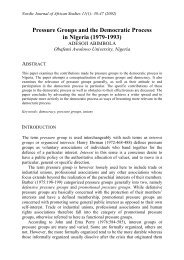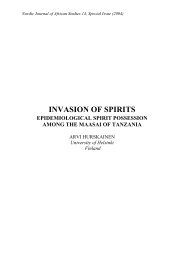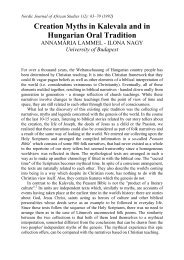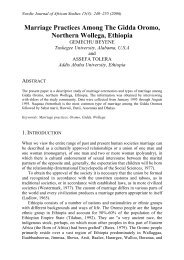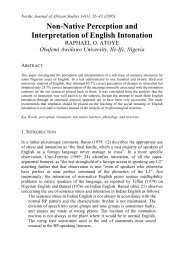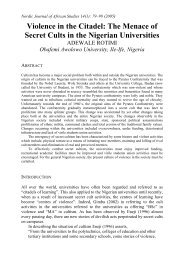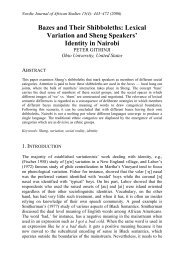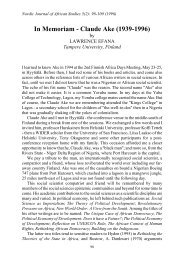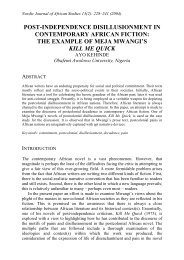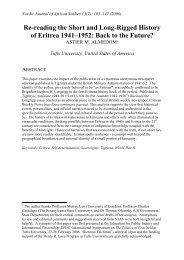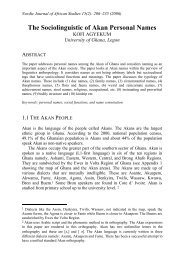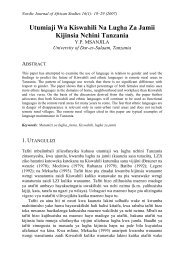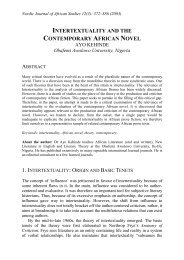Hottentot, Bushman, Kaffir: Taxonomic Tendencies in Nineteenth
Hottentot, Bushman, Kaffir: Taxonomic Tendencies in Nineteenth
Hottentot, Bushman, Kaffir: Taxonomic Tendencies in Nineteenth
Create successful ePaper yourself
Turn your PDF publications into a flip-book with our unique Google optimized e-Paper software.
Nordic Journal of African Studies<br />
documents the role imag<strong>in</strong>ative literature played <strong>in</strong> dissem<strong>in</strong>at<strong>in</strong>g farfetched racist<br />
ideas to English readers (Hammond and Jablow 1970; Killam 1968). Such<br />
value-laden discourse, directed at a mass audience, probably did more collective<br />
harm than the published papers of scientists, many of whom <strong>in</strong> the latter half of the<br />
n<strong>in</strong>eteenth century became <strong>in</strong>creas<strong>in</strong>gly preoccupied with formulat<strong>in</strong>g ’objective’<br />
racial theories based on comparisons of quantitative data derived from precise<br />
measurements of various anatomical parts, especially the skull (Gould 1981). But<br />
the subjectivity of the pop writers and the objectivity of the scientists po<strong>in</strong>ted<br />
toward the same conclusions because they were based on the same premise: that<br />
Africans were by nature <strong>in</strong>ferior to Europeans.<br />
Among men and women of conscience it was believed that this <strong>in</strong>herent<br />
difference <strong>in</strong> biological status made certa<strong>in</strong> moral demands upon the superior race.<br />
Clearly it was unethical to enslave an <strong>in</strong>ferior, but it was considered perverse to<br />
marry one. In deal<strong>in</strong>g with subnormal human be<strong>in</strong>gs some balance had to be<br />
achieved between enforc<strong>in</strong>g total social control and allow<strong>in</strong>g absolute personal<br />
freedom. Blacks had to be released from oppressive physical captivity yet kept<br />
strictly conf<strong>in</strong>ed to their proper biological niche at the bottom of the natural human<br />
ladder. The civilized and the savage had to rema<strong>in</strong> distanced from one another, if<br />
only to prevent disastrous taxonomic confusion. For otherwise the neat,<br />
color-coded dist<strong>in</strong>ctions that marked significant gradations <strong>in</strong> varieties of mank<strong>in</strong>d<br />
could become blurred and <strong>in</strong>decipherable. It would then be impossible to<br />
dist<strong>in</strong>guish at a glance between the Self and the Other.<br />
One very effective method of distanc<strong>in</strong>g Africans from Europeans was though<br />
visual images. Even the illiterate masses could understand a picture, and the picture<br />
didn't have to be accurate to convey a powerful impression. Indeed, before the<br />
advent of photography, hand-drawn sketches of black people functioned as a k<strong>in</strong>d<br />
of ocular shorthand, reduc<strong>in</strong>g complex human be<strong>in</strong>gs to a pattern of schematic l<strong>in</strong>es<br />
meant to represent their essence. Some of this racial iconography aspired to exact<br />
representation undistorted by bias or overstatement, but much of it consciously or<br />
unconsciously expressed a bigoted attitude toward the <strong>in</strong>dividual or group depicted,<br />
emphasiz<strong>in</strong>g differences that set this race apart from others. Blacks were thus made<br />
to appear less than fully human at precisely the time their full human rights were<br />
be<strong>in</strong>g secured through legislation. The paradoxes of British racial paternalism are<br />
<strong>in</strong>delibly <strong>in</strong>scribed <strong>in</strong> the visual arts of the n<strong>in</strong>eteenth century, particularly <strong>in</strong> those<br />
arts that forthrightly aided and abetted racist th<strong>in</strong>k<strong>in</strong>g.<br />
Racial arguments were advanced <strong>in</strong> media rang<strong>in</strong>g from careful illustrations <strong>in</strong><br />
scientific texts to highly exaggerated political caricatures and lampoons, from<br />
picturesque portraits <strong>in</strong> travel books to grotesque images on posters and handbills<br />
advertis<strong>in</strong>g ethnic enterta<strong>in</strong>ments. Some of the best examples of this graphic<br />
tradition can be found <strong>in</strong> depictions of three southern African peoples: the<br />
Khoikhoi, the San and the Zulu, popularly known throughout the n<strong>in</strong>eteenth century<br />
as the <strong>Hottentot</strong>, the <strong>Bushman</strong> and the <strong>Kaffir</strong>. What may have made these three<br />
African ethnic groups more visible <strong>in</strong> British art than others was the fact that<br />
specimens of each occasionally were conveyed to England and displayed publicly<br />
2



